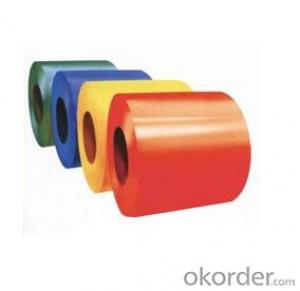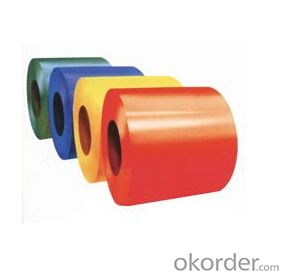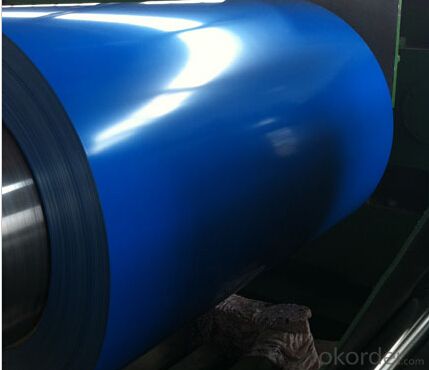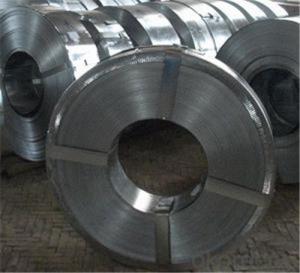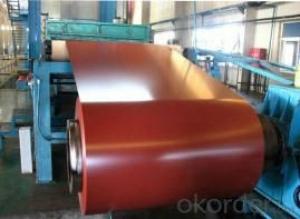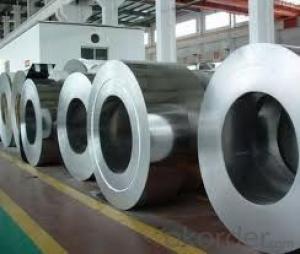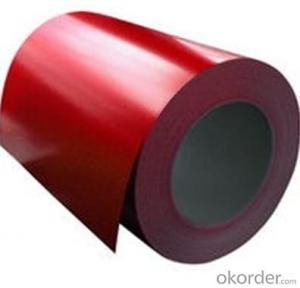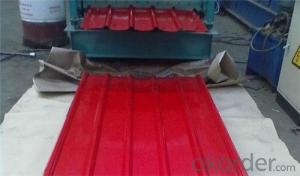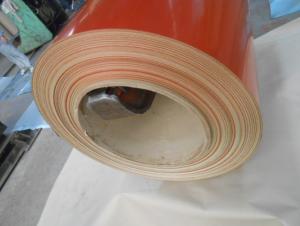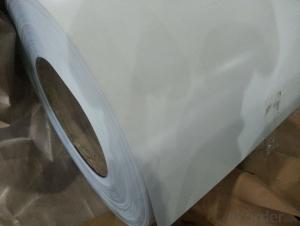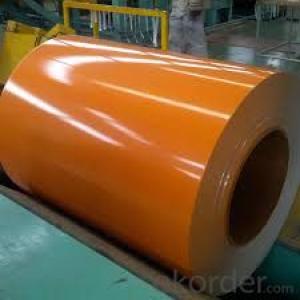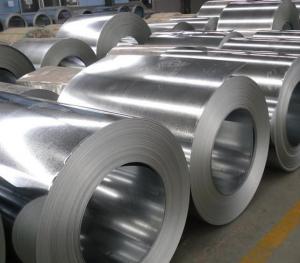Color Coated Steel Coils Based on Gi Coils
- Loading Port:
- Tianjin
- Payment Terms:
- TT OR LC
- Min Order Qty:
- 25 m.t.
- Supply Capability:
- 10000 m.t./month
OKorder Service Pledge
OKorder Financial Service
You Might Also Like
Description.
Surface Treatment:Coated
Technique:Cold Rolled
Standard:JIS
Type:Steel Coil
Special Use:High-Strength Steel Plate
Application:Building Material, Roofing, Household Appliance, E
Export Markets:Global
Additional Info.
Trademark:TOPS
Packing:Standard Export and Seaworthy Packing
Standard:GB/T12754, JIS3312, EN 10169 ASTM A755
Origin:China
Product Description
Color coated Prepainted Galvanized Steel Coils
Grade: SGCC, DX51D, CGCC
Thick: 0.17-0.8, Width: 58-1250mm
Coat: PE, SMP, HDP, PVDF
PPGI PPGL Prepainted Steel coil:
Color coated Prepainted galvanized Steel Coils
Certificate: ISO 9001/14001
The main specification is as belows:
Standards: GB/T12754, JIS3312, EN 10169 ASTM A755
Thickness: 0.14-0.8mm; Width: 914-1250mm
Tolerance: +2/0mm, thickness tolerance: +0.02/-0.02mm (or according to customers' request).
Coating mass: Top; 13-25, Back: 5-10
Coil weight: 5-8 metric tons
Coil DM: I. D: Φ 508m/610mm O. D: Max Φ 1500mm
Coating type: PE, SMP, HDP, PVDF
Common performance of front coating:
(1). Thickness: ≥ 20μ M
(2). Pencil Hardness: 2H
(3). 60° Specular glossiness of coating: >60
(4). 180° Bend: ≤ 3T
(5). Impact: ≥ 9J
(6). Salt Fog Resistant: ≥ 500h
(7). Color difference: <3Δ E
Application
1. Construction: (Outside) workshop, agricultural warehouse, residential precast unit, corrugated roof, wall, rainwater drainage pipe, terrace, retailer booth, roller shutter door
(Inside) door, doorcase, light steel roof structure, folding screen, ceiling, elevator, stairway, vent gutter
2. Electrical appliance: Refrigerator, washer, switch cabinet, instrument cabinet, air conditioning, micro-wave oven, bread maker
3. Furniture: Central heating slice, lampshade, chifforobe, desk, bed, locker, bookshelf
4. Carrying trade: Exterior decoration of auto and train, clapboard, container, isolation lairage, isolation board
5. Others: Writing panel, garbage can, billboard, timekeeper, typewriter, instrument panel, weight sensor, photographic equipment
| NAME | PPGI | GALVANIZED | GALVALUME/ALUZINC |
| CERTIFICATE | ISO9001 | ||
| STANDARD | GB/T-12754 JIS G 3312 EN 10169 ASTM A755 | GB/T-2518 JIS G 3302 EN 10142/10427 ASTM A653 | GB/T-14798 JIS G 3321 EN 10215 ASTM A792 |
| GRADE | SGCC DX51D SGCH CGCD1-CGCD3 CGC340-CGC570 GRADE | SS GRADE33-80 SGCC SGCH SGCD1-SGCD3 SGC340-SGC570 SGCC DX51D | GRADE33-80 SGLCC SGLCD SGLCDD SGLC400-SGLC570 SZACC SZACH SZAC340R |
| MODEL NO | 0.16MM-1.0MM*1250MM OR UNDER | (0.12-1.5)*1250MM OR UNDER | 0.16MM-1.5MM*1250MM OR UNDER |
| TYPE | Steel coil Steel sheets/plates Corrugated steel sheets/plates | Steel coil Steel sheets/plates Corrugated steel sheets/plates | Steel coil Steel sheets/plates Corrugated steel sheets/plates |
| TECHNIQUE | Hot rolled-cold rolled -galvalume /galvanized -PPGI/PPGL | Hot rolled-cold rolled - galvanized | Hot rolled-cold rolled -galvalume /Aluzinc |
| SURFACE TREATMENT | Mini/regular/big/zero spangle, Chromate treatment /chromate-free treatment /untreated unoile/oiled, TENSION LEVELLERT SKIN PASS anti-fingerprint/un-anti-fingerprint, Coating,color | Mini/regular/big/zero spangle, Chromate treatment /chromate-free treatment /untreated unoile/oiled, TENSION LEVELLERT SKIN PASS anti-fingerprint/un-anti-fingerprint, Coating | |
| APPLICATION | Structural use ,roofing, corrugated roofing, commercial use, household appliance, industry, family | ||
| SPECIAL APPLICATION | Wear resistant steel, high- strength - steel plate | ||
FAQ
1.What's your MOQ?
25MT, it is for one container.
2.Do you have QC teams?
Yeah, sure, our QC team is very important, they will keep the quality control for our products.
3. What's your normal delivery time?
Our delivery time about 10-20days for standard sizes, if you have other requirements like hardness and width ,it is about 20-40days. But don't worry ,we also try our best for the delivery time ,because time longer and our cost is higher.
4.Are the products tested before shipping?
Yes, all of our PPGI and GI was qualified before shipping. We test every batch every day.
- Q: How are steel coils used in the production of metal enclosures?
- Steel coils are widely used in the production of metal enclosures due to their versatility and strength. These coils, which are typically made from high-quality steel, serve as the primary raw material for manufacturing metal enclosures. Firstly, the steel coils are unrolled and flattened to the desired thickness using specialized machinery. This process ensures that the coils are in a suitable form for further processing. The flattened steel is then cut into specific sizes and shapes, depending on the design requirements for the metal enclosure. Next, the cut steel pieces are formed into the desired shape using various techniques such as bending, folding, and welding. These processes allow the steel to be molded into the required dimensions and structure of the metal enclosure. The inherent strength and durability of the steel coils ensure that the final product is sturdy and can withstand external forces or impacts. Additionally, steel coils can be coated with protective layers such as galvanization or powder coating to enhance their resistance to corrosion, rust, or other environmental factors. This coating helps to prolong the lifespan of the metal enclosure and maintain its aesthetic appeal. Moreover, the use of steel coils in the production of metal enclosures allows for customization and flexibility. The coils can be easily manipulated to create complex shapes or designs, enabling manufacturers to cater to specific customer requirements. This adaptability makes steel coils a preferred choice in industries such as automotive, electronics, and construction, where metal enclosures are widely used. In summary, steel coils play a crucial role in the production of metal enclosures by providing a strong and versatile raw material. These coils are transformed into the desired shape and size, ensuring the durability and functionality of the enclosures. With their customizable nature and protective coatings, steel coils offer a cost-effective solution for manufacturing high-quality metal enclosures.
- Q: Is condensation on steel caused from water being pulled out or is the condensation formed from the air around the steel object?
- When moist air comes in contact with the cooler steel, the water vapor changes to a liquid or condenses. Steel is made of iron and carbon, not water.
- Q: I work with stainless steel a lot and I know it's rust resistant but it's definitly not STAIN resistant. You might be able to remove some stains easier from it than you can from some other surfaces but when it does stain, its hard as heck to clean it. It takes forever to scrub stains off my stainless steel pans so maybe it should just be called rustless steel?
- This okorder /
- Q: How much do steel coils weigh?
- The weight of steel coils can vary depending on their size and thickness, but on average, they can weigh anywhere from a few hundred pounds to several tons.
- Q: i have recently gotten into DIY and am planning on making my own knife. My question is what kind of steel would be good to use for heat treating if i plan on using water and not oil in the process.
- Go to junkyard get old leaf spring, cut out knife, start sharpening. Why waste time heat treating steel when the spring steel as already be done.
- Q: How are steel coils used in the production of metal signs?
- Steel coils are used in the production of metal signs by being processed through a series of steps such as cutting, shaping, and welding. The coils are uncoiled and cut into the desired size and shape for the sign. Then, they are shaped using various methods like bending or rolling to achieve the desired design. The coils may also undergo welding to join different sections or add additional components to the sign. Overall, steel coils provide the raw material necessary for creating durable and sturdy metal signs.
- Q: How are steel coils shaped into specific forms?
- Steel coils are shaped into specific forms through a process called cold forming or cold rolling. This involves passing the steel coil through a series of rollers that gradually shape and form it into the desired shape, such as sheets, strips, or tubes. The precise dimensions and specifications of the final form are achieved by adjusting the pressure and alignment of the rollers.
- Q: What are the different coil surface finishes?
- The different coil surface finishes include mill finish, brushed finish, embossed finish, polished finish, and coated finish.
- Q: What are the different grades of steel used for manufacturing coils?
- Manufacturing coils requires the use of various grades of steel, each selected for their specific properties and suitability for different purposes. Some commonly used grades include low carbon steel, high carbon steel, stainless steel, galvanized steel, and alloy steel. Low carbon steel, also known as mild steel, is a cost-effective option with good formability. It is ideal for applications that require low strength and high ductility, such as automotive components and construction materials. High carbon steel is characterized by its exceptional strength and hardness. It is commonly employed in the production of coils that demand high tensile strength, like springs and wires. Stainless steel, an alloy with a high chromium content, offers corrosion and oxidation resistance. It is often utilized in the manufacturing of coils for the food industry, medical equipment, and automotive applications. Galvanized steel, on the other hand, is steel coated with a layer of zinc to safeguard it against corrosion. It is frequently used in the production of coils that will be exposed to harsh environmental conditions or require excellent durability, such as roofing materials and electrical appliances. Alloy steel, formed by adding elements like manganese, nickel, chromium, or molybdenum to carbon steel, exhibits improved strength, hardness, and resistance to wear and corrosion. It finds wide application in industries that necessitate high strength and toughness, such as aerospace and automotive. Choosing the appropriate grade of steel is crucial to ensure optimal performance and longevity of the coils, as it is essential to match the specific requirements of the application.
- Q: I'm searching for the elastic modulus of ASTM A653 galvanized steel sheet. Max points for first person with a response that includes web address of reliable reference - I just haven't found it yet. thanks!
- Aluminum is non ferrous so a magnet won't persist with it, and this is softer than steel. once you have desperate that, if it has previous paint on it, this is particularly helpful to apply a primer that corresponds to the paint you would be utilising the two vinyl or oil based, then paint. this is possibly no longer Galvanized, yet whilst this is, the unpainted floor with have a 2 colour steel Spackle look.
Send your message to us
Color Coated Steel Coils Based on Gi Coils
- Loading Port:
- Tianjin
- Payment Terms:
- TT OR LC
- Min Order Qty:
- 25 m.t.
- Supply Capability:
- 10000 m.t./month
OKorder Service Pledge
OKorder Financial Service
Similar products
Hot products
Hot Searches
Related keywords
